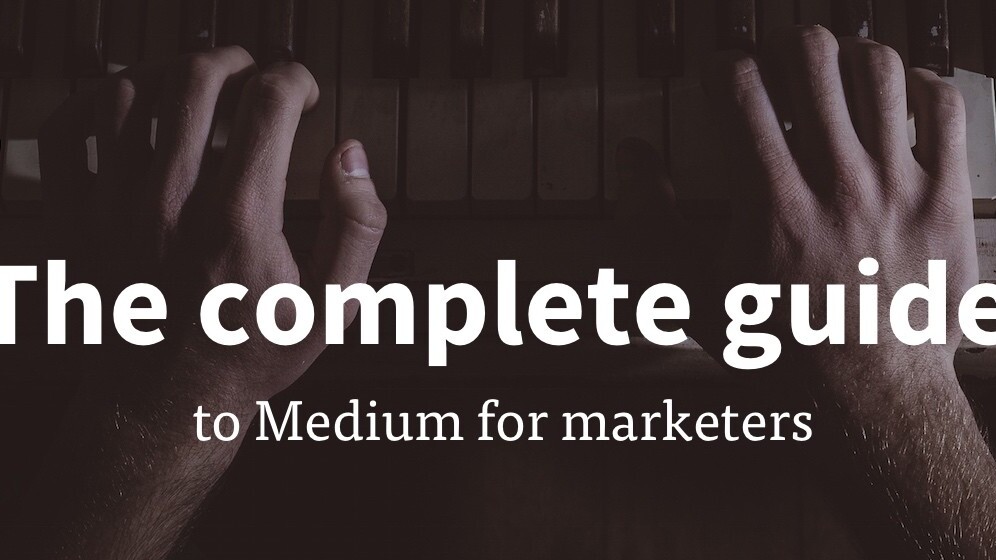
This post first appeared on Buffer.
Imagine starting a blog with zero overhead. Imagine having a place online to write your thoughts, tips, and learnings and share with a built-in audience and an immediate potential for viral traffic. Imagine a really great writing app.
This is Medium, a blogging platform from the creator of Blogger and Twitter. It’s slick and snappy and could very well be worth a deeper look for digital marketers and first-time bloggers.
We’ve enjoyed experimenting with the best way to use Medium here at Buffer, and we’re eager to learn more about what the best practices might be for helping the Medium community and engaging with an audience. If you’re new to Medium, I’ve collected an overview of resources here in this post, and for those who have been Medium users already, I’ve added several tips and learnings that we’ve discovered along the way.
The Complete Beginner’s Guide to Medium
Medium is a place to write.
One discussion that comes up often about Medium is whether it strives to be a platform or a publisher, i.e. a place for others to share what they think (like Twitter) or a place for Medium to share what it thinks (like BuzzFeed).
The answer isn’t all that important for marketers. Know this, Medium is a cool new place to share your writing or to start your writing, as easy as can be.
How it works—Medium for writers
Anyone (or any brand) can sign up for a free Medium account and start writing.
Writers can publish individual, stand-alone posts or contribute to publications of curated stories or curate a publication themselves.
Posts – Anything goes with the posts on Medium. Written by journalists, bloggers, companies, and brands, the articles on Medium range from short-form to long-form, light to deep, full posts or teasers of existing content elsewhere. The topics cover just about anything.
Here are a few popular Medium posts that highlight the variety of content on the network.
- A Teenager’s View on Social Media
- A mile wide, an inch deep
- Today I Learned Something about My Boyfriend That No Girl Should Ever Have to Discover
- Your Content Feed is Broken
- Age 40: Ain’t Nobody Got Time For That
- 3,200 hours
Publications – Formerly called “Collections,” publications collect articles into a curated set of posts. Any one post can only be included in one publication.
Here are a few Medium publications to browse.
How it works—Medium for readers
You’ll find a host of similarities between Medium and anywhere else you read content online. At Medium, you still have the ability to comment on (with a twist), recommend, and share posts, with a few added elements that are unique to Medium.
Find and follow – You can follow individual writers and publications, and the more you follow, the more variety you’ll see on your homepage. The Medium homepage displays recent and popular stories from the writers and publications you follow.
Comment – Medium’s unique approach to comments allows you to leave notes in the margins of the story at the exact location you choose.
Here’re a couple of neat ways to use notes:
- Request notes before you publish. You can invite collaborators and editors to look at your post before hitting publish. These folks can then add notes throughout the article, much like a collaborative document in Google Drive for instance. Bonus: Anyone who contributes to your final article gets a nice automatic mention at the end.
- Use notes as footnotes. You can leave comments on your own articles, treating these notes as footnotes with extra context.
Recommend – Every post has a recommend button at the end.
Share – You can share to Twitter, Facebook, and email.
Bookmark – Save a post to read later. A reading list appears on your homepage.
Respond – Write a new post in response to an existing post.
Formatting tips
Medium is both a beautiful writing experience for the writers and a beautiful reading experience for readers. Here are a few great example articles that highlight the storytelling design elements you can include in your Medium post.
- The Mercenary
- When The River Runs Black
- Einstein’s Camera
- Corg Life: “Stuck in the Middle”
- Pretty much everything in the Beautiful Stories Collection
Writers can choose from a set list of different elements to spice up the design of a post.
First, there are different headline arrangements and styles.
Second, there are several different ways to display photos in your post, either as background images, full-width images, inline images, or aligned images.
All of these formatting options come available while writing and editing by either selecting text or by clicking the “+” button that hovers on the page.
About Medium’s blogging stats and metrics
Another unique thing about Medium is the way that it focuses its stats and metrics for posts. Instead of focusing directly on visits or views, Medium seeks to assess a post’s read ratio.
Julie Neidlinger of CoSchedule has a great way of summarizing the distinction this makes.
Instead of a focus on traffic, Medium is focusing on readers.
1. Medium is basing discovery of your content on whether or not people have read it. Not hits, not sexy headlines. Readability, not gimmicks or tricks, wins.
2. Do you notice how Medium, on its dashboard and elsewhere, does not refer to what you write as blog posts, or content? It calls them stories, and that’s the key here. Medium wants your stories.
One way that Medium emphasizes this focus on readers is in its ubiquitous display of reading time on all posts. Readers can know immediately how much is required of them to read through an entire story.
For writers, Medium shows you a 30-day snapshot of all your posts and their views, reads, and recommendations. You can also drill down further into each post to see where the traffic came from.
- Views – How many people saw your post
- Reads – How many people saw your post and took the time to read it
- Read ratio – How many people actually read your post out of all those who saw it
- Recommendations – The number of people who recommend your post
Each of these factors works into the Medium algorithm, which helps determine the posts that get featured around the site and in email digests.
Time-saving Medium tips
Medium has a full list of keyboard shortcuts for working fast while writing and editing. Here’s a peek at the shortcuts for Windows.
Here’s the list of keyboard shortcuts for Medium on Windows:
Ctrl + Alt + 0 = Starts a new paragraph
Ctrl + Alt + 1 = Turns a text block into / starts a new Heading 1 style
Ctrl + Alt + 2 = Turns a text block into / starts a new Heading 2 style
Ctrl + Alt + 5 = Turns a text block into / starts a new BlockQuote style
Ctrl + Alt + 6 = Turns a text block into / starts a new Code style
Ctrl + Alt + 3 = Turns a text block into / starts a new Heading 3 styleCtrl + b = Turns selected text into bold style
Ctrl + k = Adds a new link
Ctrl + i = Turns selected text into italic style
Ctrl + e = Centers text. This shortcut presumably replaces the now removed Pullquote shortcut, minus the font size (Ctrl + 7, no longer working)Ctrl + : = brings up the shortcut menu with most of the keyboard shortcuts (not all).
In addition, Medium supports third party embeds, meaning you can share a URL from a favorite service and the media will be automatically included (in a smooth design) inside your post. Medium supports the following third-party sites:
- Youtube
- Vimeo
- Vine
- Kickstarter
- SoundCloud
- Rd.io
- Github gists
Here’s an example of an Rdio embed.
As the network has grown, Medium has done a great job sharing tips and tricks for writers to achieve success on Medium. (Their data post about optimal blog length is one we’ve referenced often.)
This advice took the form of best practices back in 2013, many of which still hold true today. Here’s the list, shared by Medium.
- While there is no designated word count for any story on Medium, stories of 400 words and up have generally been the most popular.
- Write a headline that best reveals the gist of your story.
- Choose a high-quality photo (minimum 900 pixels, or 900×900) for the top of the story. Horizontal images work better than vertical.
- Where appropriate, make use of Medium’s formatting features: two levels of headlines, Notes for footnotes, hyperlinks, and section separators.
- Get feedback on your draft, and proofread for grammar, punctuation, and formatting.
- Submit to relevant Medium collections (now called “publications”).
Should you use Medium for your writing?
As we dive into the stats on Medium (see below for even more), one of the ones that stands out initially is this: Medium has more than 650,000 users.
(All users by default follow the Editors Picks collection, which has 651k followers, we can assume the number is somewhere around there.)
For those just starting out with a blog, Medium has a huge built-in audience. It cuts out the pressure of setting up and maintaining your own blog, and the potential for a viral hit appears to be great with the mechanisms and audience already in place.
For those who are new to blogging, Medium is a great choice to get started.
For those who already have a blogging presence online, there’s likely more to consider.
One of the most interesting discussions I’ve heard on the topic is the idea ofsharecropping (HT to Julie Neidlinger for the term). Sharecropping is publishing some place you don’t control.
It’s a question of owned media (a blog on your own server) versus earned media.
I like the way that Ann Friedman puts it in this answer about where she publishes her uncompensated work.
I try to only publish uncompensated work on platforms that I own myself. I’ll post something to my own blog, for example, rather than have it run for free on the Huffington Post or Medium, because I want people to at least see my name at the top of the site, and perhaps look at more of my work—which is an advantage I don’t enjoy if I write for free on someone else’s site.
Should you join Medium if you have a separate, owned channel to share your writing? I can definitely see the case for either way, and as you’ll read below, there may even be some good go-between options that cover both sides.
The Medium Guide for Marketers
The amount of traffic you can expect on a new post
What kind of traffic can you expect to get from Medium?
Actual numbers on this are a bit hard to come by. A few folks have been kind to share their stats, and I’ve bundled up all the stats from our various team member posts here at Buffer to help give you an idea of the volume that’s out there at Medium.
A few of the posts we’ve written have taken off more so than others. There’s a pretty good representation of a variety of success here in the list. Take a look.
How well does content do on Medium? Or, does it do well enough to publish your stuff there?
The answer will likely depend on what you’re able to get on your personal blog.
Mike Essex tested the results for his writing on Medium and found that publishing there was well worth his time.
Within 6 hours my post on Medium had surpassed the average number of views a post on my site would get in its entire lifetime. Within 24 hours those numbers quadrupled.
How to write a Medium headline
Another unique part of Medium is the way that headlines are built. The SEO headline is less common on Medium than on other blogs around the Internet. Since content is found inside the network, it’s more about writing a headline that resonates with the reader.
For this reason, the Top 100 list of Medium posts will have a wide assortment of different types of headlines.
- How to
- Full sentences
- Super short
- Super long
I pulled a list of the character counts for the Top 100 stories from January and found that the average length is 42 characters. For reference, this headline from the Top 100 is 41 characters:
I Almost Let My Failed Startup Destroy Me
And of course, one of our best headline tips for headlines anywhere (blogs or tweets, etc.) is that your first three words and your last three words will be noticed the most. Make those six words count.
The average length of the most-read stories
Likewise, I also looked at the reading lengths of the Top 100 Medium stories from January. Since reading time carries such an emphasis on the network, it might seem that there’d be a good recommendation on exactly how long to write a Medium post.
The average length of a Top 100 post: 7.25 minutes
There was a huge amount of variety on this list as well (the median was 6 minutes). In the Top 10, there were posts as short as 3 minutes and as long as 28.
Also, some of the best advice on length, timing, etc. with Medium posts comesfrom the Medium data team. There is a direct correlation to how long people spend on their posts and how well the posts perform. Quality trumps all.
5 Growth Hacks for Medium
1. Repost your content on Medium
One of the most obvious growth hacks—and one that we’ve tried ourselves at Buffer—is to repost your content on Medium. You expose it to a new audience and give it a chance to gain traction anew.
The team at Unbounce tried this on a recent post and received 144 additional views, a great number for little effort.
Other places that aim for this include The Physics ArXiv Blog, Edible Manhattan and Fader.
2. Link back to your website or blog
Medium gives you huge amounts of creative liberties with the way you create your posts. One interesting method that I’ve seen used a lot is to leverage the end of your post as a place to link back and share a call-to-action or a referral to your blog.
KISSmetrics shared a neat example from Raymmar Tirado who links to his website at the end of each article, and he sometimes includes links to his site in the middle of his posts.
Tirado says:
[One thing I appreciate about Medium] is the ability to link to content outside of Medium inside of my articles. This allows me to drive little pockets of highly engaged traffic to places on my website that correlate with the information inside of the article.
You can also think about adding a CTA to follow on social media or join an emailing list or try out a new product/download.
3. Create a publication for your brand
We’ve built a Buffer publication where we house the articles written by the team at Buffer.
You can do the same for your brand, creating a publication of content from your team, content on a particular topic, or any other theme you can imagine.
The Physics ArXiv Blog made Medium its permanent home. The List is another site that does this.
4. Explore visual content
Medium is for writers. Writers can be visual artists.
Some of the popular content on Medium amounts to little more than a cartoon or series of images. This visual content is striking in its place beside written content. It looks great beside articles of 5 to 7 minutes, while it stands at 2.
Check out comics from Gemma Correll or the I Love Charts publication for some inspiration.
5. Track visits back to your website with UTM parameters
Another great tip from Chloe Mason Gray at KISSmetrics is to see which posts on Medium are bringing the most traffic back to your website by tracking with UTM parameters.
Go to Google’s UTM tool to place tracking links on the URLs that link back to your site.
This can be helpful in iterating on the text in your calls-to-action as well as finding the spots within your post (in the intro, in callouts, etc.) that are best used for links back to your page.
Summary
Medium is a really unique part of the social tools landscape—a mix of collaborative software like Blogger and social reading experiences like Twitter and others.
For those just starting out with blogging, Medium is a simple and easy place to get going.
For brands looking to expand their reach to a built-in audience, there are some really neat ways to do so with Medium.
For others curious about what Medium offers, feel free to grab your name and reserve your spot and build a bit of a presence by reposting content or engaging with your audience that’s on there.
What has been your experience on Medium so far? Any tips to share? Feel free to share in the comments.
Read Next: 18 incredibly useful tools for getting to know your audience better
Image sources: IconFinder, Blurgrounds, Unsplash
Get the TNW newsletter
Get the most important tech news in your inbox each week.













